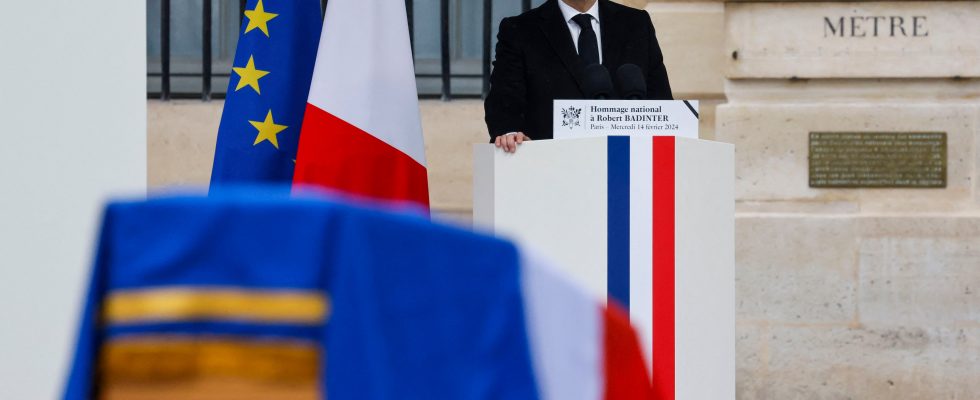“Great men the grateful country”. The famous motto inscribed on the pediment of the Pantheon in Paris seems to be cut for Robert Badinter. The former Minister of Justice was indeed “a great man”, Emmanuel Macron agreed on Friday February 9, after the announcement of the death of the former Minister of Justice, a “wise man” and a “republican conscience”.
This Wednesday, February 14, the President of the Republic presided over a national tribute to Robert Badinter on Place Vendôme, headquarters of the Ministry of Justice where he brought about the abolition of the death penalty, indicating in his speech that “opens the time of recognition of the nation” and saying he was in favor of his entry into the Pantheon. “Your name must be included alongside those who have done so much for human progress and for France and await you at the Pantheon,” announced Emmanuel Macron.
Previously, the first secretary of the Socialist Party Olivier Faure had officially made the request for pantheonization of Robert Badinter to the Head of State, in a letter revealed Tuesday by Release. A “legitimate” request because in the Pantheon it is “the great men who brought great ideas”, estimated this Wednesday on franceinfo the president of the Constitutional Council Laurent Fabius, a position occupied by Robert Badinter from 1986 to 1995.
A prerogative of the head of state
As recalled The world, it was originally the Constituent Assembly which took the first decision to bury a personality in the Pantheon, before the Convention took over in 1794. Napoleon I then assumed this prerogative. Under the Third Republic, deputies once again seized this right.
Since the establishment of the Fifth Republic in 1958, this prerogative has fallen to the President of the Republic. “This is part of the redefinition of its attributions, even if it is not specified in the Constitution,” explained in the world in 2017 Patrick Garcia, professor at the University of Cergy-Pontoise. “Nothing is codified, the President alone chooses and the decision is implemented by the Ministry of Culture,” he added.
The question of the pantheonization of Robert Badinter recalls that of Simone Veil, whose death, on June 30, 2017, also caused a lot of emotion and led to a request for immediate entry into the Pantheon. The announcement of the pantheonization of the Auschwitz survivor was made in record time by a head of state: Emmanuel Macron announced it just five days after the death of this figure in French and European political life.
No text sets entry criteria
If the Pantheon is reserved for “great men who have deserved national recognition”, however, no text details the merits requested. There is in fact no text establishing the exact criteria for entry into the Pantheon, for example age or areas of expertise. In addition, no document indicates that you must be of French nationality. However, there are implicit criteria: an exemplary personality, who embodies the values and ideals of the Republic and whose ideas echo the values of the Head of State.
The choice is therefore left to the discretion of the President of the Republic. In addition to Simone Veil, Emmanuel Macron brought into the secular necropolis the writer and former Poilu Maurice Genevoix, who died in 1980. With Maurice Genevoix, chronicler of the horror of the trenches of the First World War, these are “all those of 14 “, these “ordinary heroes”, whom Emmanuel Macron heard honored on November 11, 2020.
The President of the Republic also admitted Joséphine Baker on November 30, 2021. The music hall star, French-American resistance fighter and anti-racist activist was the first black personality and the first artist to join the Pantheon. Missak Manouchian, of Armenian origin, will be the first foreign and communist resistance fighter to enter the Pantheon on February 21, 80 years after his execution by the Germans in 1944. A way for Emmanuel Macron to pay tribute to through him, to all his foreign comrades in arms, Spaniards, Italians or Jews from Central Europe.
Family consent required
Entry into the Pantheon is a relatively long process. “These things take time,” underlined the President of the Republic on Friday during a trip to Bordeaux. The Head of State, once his choice has been made, consults the descendants of the deceased personality. To enter the Pantheon, it is in fact first necessary that the person themselves or their heirs do not oppose it.
In 2021, despite a petition to this effect, Emmanuel Macron rejected the idea of welcoming the cursed poet Arthur Rimbaud to the Pantheon, thus respecting the opposition of his family who did not want his joint entry with Paul Verlaine, once his lover. General de Gaulle had specified that he did not wish to be buried in the Pantheon, while the heirs of Albert Camus did not want the writer to be honored by Nicolas Sarkozy in 2009. It is also possible to be pantheonized without being buried in the crypt, like the writer and politician Aimé Césaire, buried in Fort-de-France, in Martinique, to whom a fresco and a plaque were dedicated in the Parisian monument.
It is by decree, signed by the head of state, that entry into the Pantheon is then approved. The ceremony takes place at least several weeks, or even several months later, time to complete the preparations, in particular the walk up rue Soufflot, the speech and the solemn entry.
